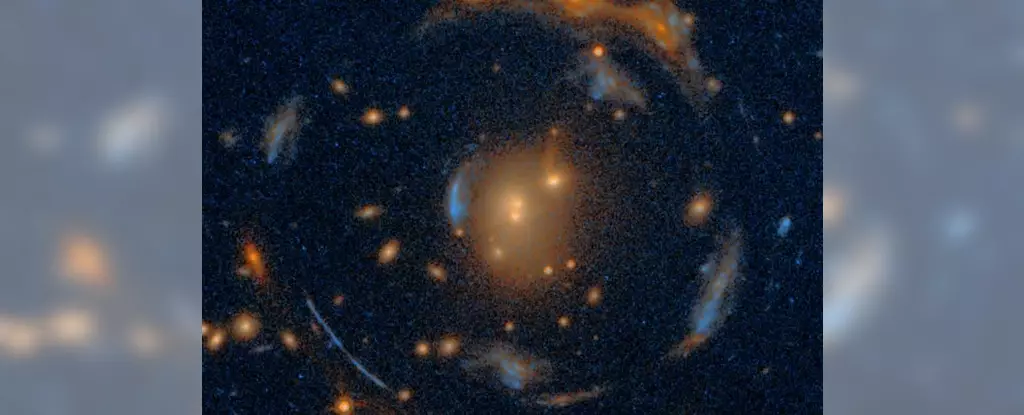Gravitational lensing stands as a fascinating phenomenon in astrophysics where massive objects, such as galaxy clusters, warp the fabric of spacetime, distorting the light emanating from more distant celestial bodies. This bending of light enables astronomers to peer deeper into the universe, offering spectacular insights that span billions of light-years. Among the myriad instances of this phenomenon lies the Carousel Lens, a striking alignment of seven background galaxies that present a unique opportunity to expand our understanding of cosmic evolution.
Recently, researchers utilizing the Hubble Space Telescope uncovered an astonishing image of the Carousel Lens, revealing how the gravitational influence of an intervening galaxy cluster distorts the appearances of distant galaxies. As articulated by David Schlegel, a senior scientist at Berkeley Lab, this discovery represents a stellar alignment—one of those rare cosmic occurrences likened to locating “a needle in the haystack,” but in this case, it’s “eight needles inside that haystack.” The Carousel Lens was initially detected from the Dark Energy Survey’s observational data, underscoring the potential of large-scale sky surveys in revealing astronomical wonders that can significantly deepen our comprehension of universe’s structure and evolution.
The Carousel Lens showcases a notable assembly of seven galaxies situated at distances ranging from 7.62 to 12 billion light-years from Earth, all shaped by the foreground galaxy cluster, designated as DESI-090.9854-35.9683, located roughly 5 billion light-years away. This cosmic alignments creates the “funhouse mirror” effect wherein the light from these distant galaxies becomes stretched and distorted, revealing intricate shapes that provide astronomers with a treasure trove of invaluable data. A centerpiece of the Carousel configuration, labeled 4a, 4b, 4c, and 4d, exhibits a striking symmetry that forms an “Einstein Cross,” characterizing the mass distribution within the lensing cluster.
As researchers delve deeper into the Carousel Lens, they envisage a host of cosmological implications. With its intricate lensing configurations—including arcs, double lensing, and distinct ring structures—this celestial spectacle serves as a practical laboratory for investigating the mass properties of the cluster itself as well as the four large galaxy members it encompasses. By exploiting these observations, astronomers aim to refine their understanding of dark matter and dark energy, foundational elements that remain largely shrouded in mystery within the field of cosmology.
Xiaoshang Huang, part of the research team at Berkeley, affirms that the Carousel Lens offers an unprecedented configuration. Its combination of strong lensing effects and multifaceted distortions allows for a nuanced examination of the distribution of normal and dark matter. The alignment of multiple galaxies behind the lens enables scientists to conduct spectral studies that can constrain the total matter content of the foreground cluster and reveal more about the universe’s composition and behavior.
Further enriching the significance of the Carousel Lens are the distant lensed sources themselves, which offer a unique window into galaxies from earlier epochs of cosmic history. For instance, one notable source, referred to as “Source 7,” is posited to be a very high-redshift galaxy exhibiting quiescent characteristics—a state where star formation has significantly diminished. The implications of studying such sources stretch far beyond mere observation; they delve into the very nature of galaxy formation and the intergalactic relationships that might have dictated their development.
The phenomenon of “early galaxy quenching,” wherein star formation ceases due to various influencing factors such as supermassive black holes and galactic mergers, provides context for understanding these distant systems. Given that interactions between galaxies were markedly common during the early universe, the Carousel Lens adds another layer of complexity regarding the dynamism of cosmic evolution.
The discovery and analysis of the Carousel Lens present exciting frontiers in astrophysical research and cosmology. The gravitational lens not only acts as a magnificent illustration of nature’s capabilities but also paves the way for unraveling some of the universe’s enduring enigmas. As astronomers continue to harness the power of gravitational lensing, findings from the Carousel Lens will undoubtedly illuminate pathways toward a deeper understanding of the cosmos, unraveling the intricate tapestry that has shaped not only galaxies but the very essence of our universe.


Leave a Reply